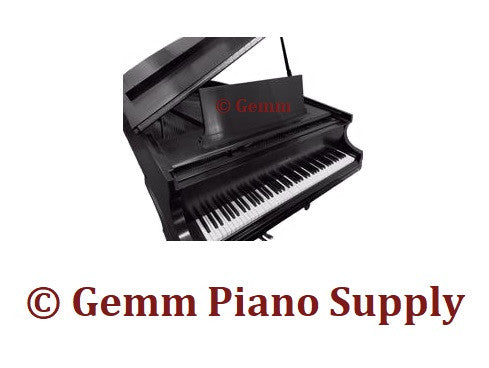Installing Tuning Pin Bushings

Wood Piano Tuning Pin Bushings
When repinning and restringing a piano, the technician has a decision to make as to whether or not to remove and replace the old tuning pin bushings. On occasions when the plate is out of the piano for pinblock replacement, or for either cleaning or repainting the plate, it is a simple choice in that it is really easier to just knock out the old bushings and replace them rather than to try to save the old.
When the plate is staying put, however, as in the case of a repinning / restringing job utilizing the old pinblock, removing the old bushings is more work.
Bushings are important for tuning pin stability, in that they provide support for the pin in between the top of the pinblock and the bottom of the string coil.
New bushings not only have a pleasing appearance, especially when seen in contrast to a newly finished case, but provide uniform support where an old set of bushings may not.
In any instance where a decision could be made one way or the other, I would recommend going the extra mile and doing the job right, to avoid having regrets later that you didn't take the time to do the job when you could.
Article courtesy Gemm Piano Supply
The easiest time to remove old tuning pin bushings is when the cast iron plate is out of the piano in the course of a pinblock replacement job.
Support the plate on sawhorses so that the tuning pin bushings are not prevented from being tapped out.

By sitting on a stool, you should be able to pull yourself up to a handy distance from the plate to work. Tap the bushings out into the waste basket using a mallet and a wooden punch.
When removing old bushings, avoid using a metal punch to tap out or install tuning pin bushings, using it will chip the lacquer finish of the plate.
Each bushing should pop loose with one or two good taps of the mallet.

Article courtesy Gemm Piano Supply
At the same time that the tuning pin bushings are removed it's a good idea to remove both agraffes and under string cloth in order to properly clean and refinish the plate.

►Caution: If agraffes are removed, be sure to keep them in order so that they may be returned to the same hole. An easy way to do this is to simply string them on a piece of piano wire as they are removed from the plate.

Article courtesy Gemm Piano Supply
Before installing new tuning pin bushings in the plate, the pin block should be supported from underneath with a Piano Pin Block Support Jack or a Piano Pin Block Support both are proper tools for the job.
Use a piece of hardwood above and below the jacks to even out the pressure. Turn the screw of the jacks up until
the pinblock is firmly supported.
Start each bushing by lining up the bushing with the hole, then rapping it once or twice with a ball peen hammer. Make sure that the bushing is going in straight.
►Caution: Be extremely careful when wielding your hammer in the vicinity of the struts of the cast iron plate.
Finish tapping each bushing in using a wooden punch the same diameter as the bushings.
A depth gauge for your drill bit should be made.
It is recommended using tape instead of a store-bought metal depth gauge. The tape will be less likely to mar the finish of the plate.
Either masking tape or electrical tape works well for the job. Change tape often to avoid the tape to bunch up.
Note: Many pianos manufactured since the mid-60's have used Tuning Pin Bushings with a smaller diameter.
Select the correct size of the tuning pin bushing by measuring your old bushing before ordening, we have various sizes available in our store.
Article courtesy Gemm Piano Supply
© Copyright material is presented for viewing purposes only, and is not intended for copying or publication.
